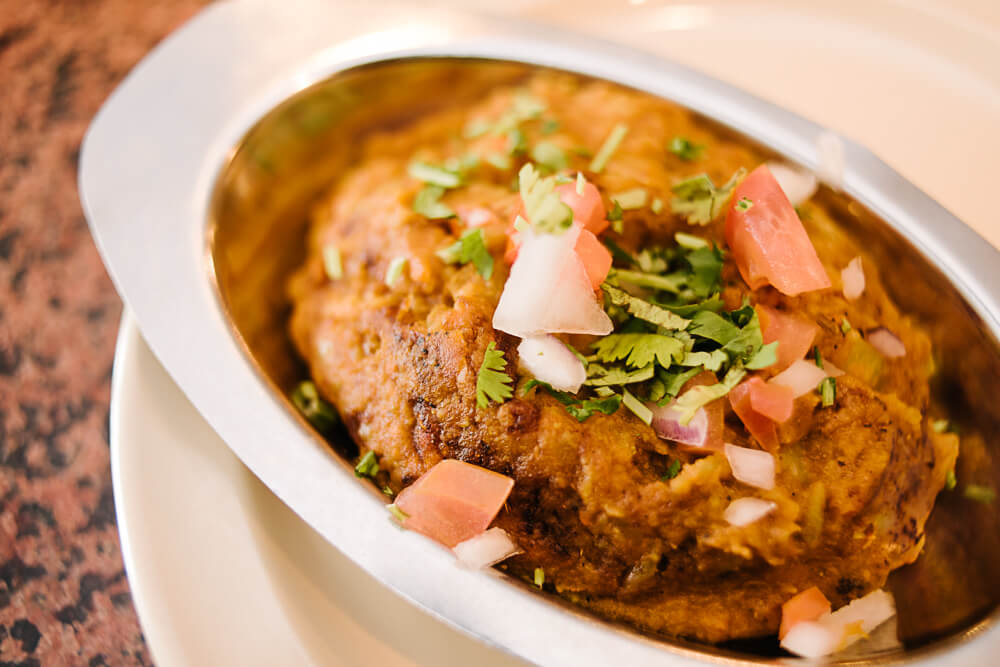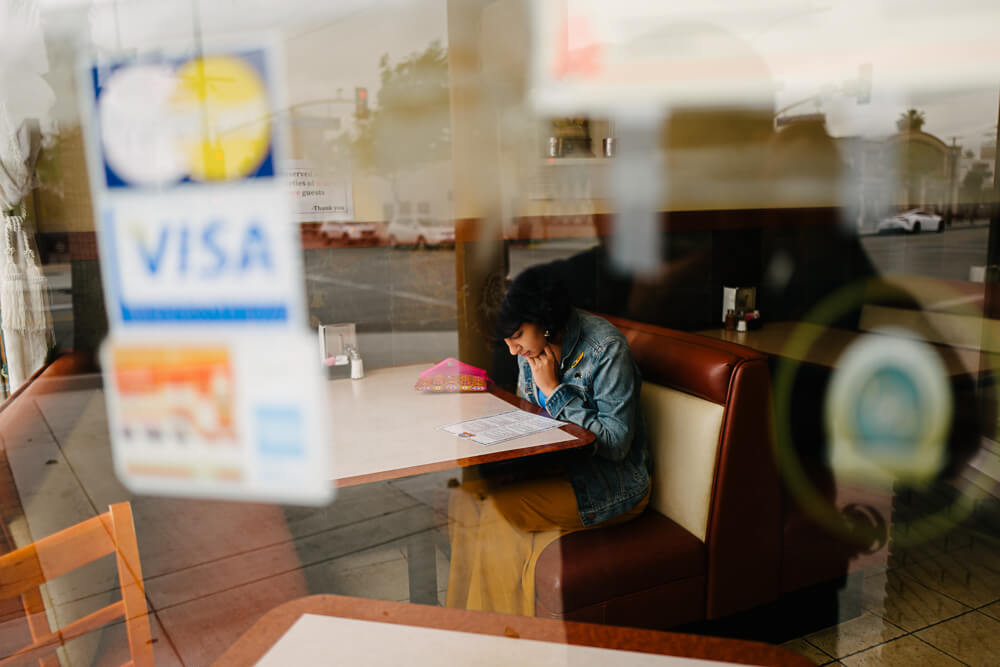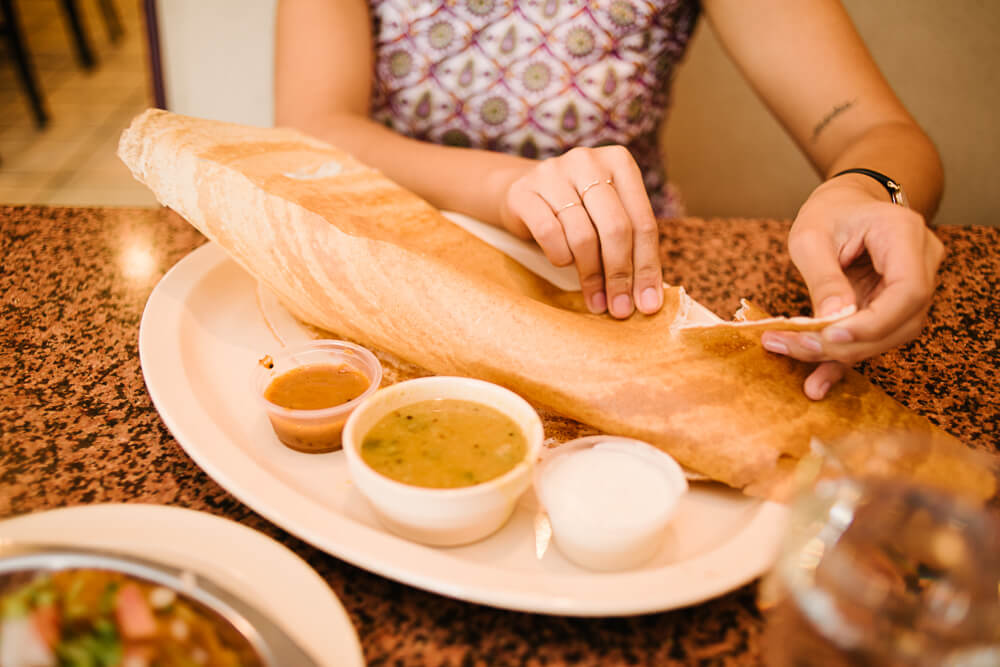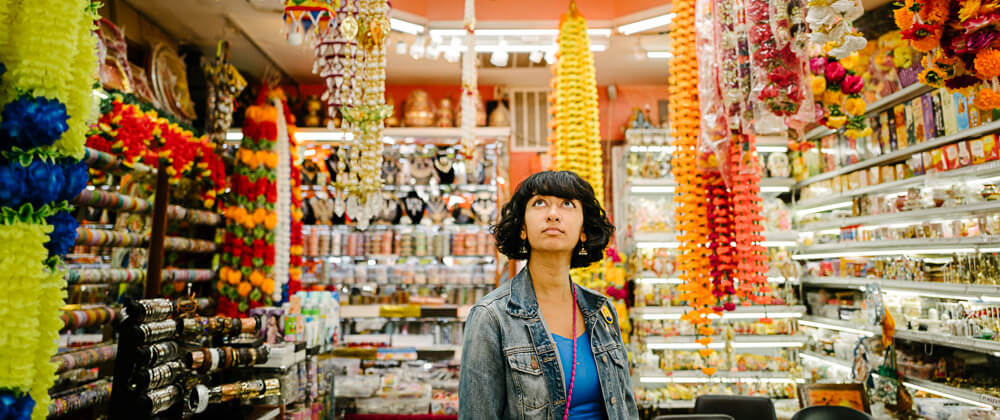I went on a hunt for a taste of Mumbai across L.A. County and discovered a culinary surprise in Culver City.
Eight months after my move to Los Angeles, I drove the 20 miles from my apartment in South L.A. down to Artesia with my then-boyfriend Peter, who is not Indian, and who I met only after moving to L.A. Dozens of people I’d met in my time in this city described Artesia as a “Little India,” which in my mind felt comparable to Edison, New Jersey. Growing up, my family and I would drive down the Garden State Parkway on Sundays, and we’d spend the day in Edison getting Indian groceries, and stopping by the parlor for my mom to get her eyebrows done before ending our visit at a restaurant.
As Peter and I sat through an hour and a half of traffic for our trip to Artesia, I felt like my parents. Like them, I was a transplant, a newcomer. The three of us immigrated to the U.S. in 1998, and their idea of a family weekend was to find the closest thing they could to their Mumbai suburb and drive to it. With Peter, I did the same, motivated by all the Indian food that was to be my pot of gold at the end of the highly-trafficked rainbow, and not-so-secretly in the hope I would find a proper Indian American community. I loved Los Angeles for the multitudes it contains. Something I found missing, however, was a significant presence of the Indian diaspora, a substantial Little India.
Getting Threaded
Artesia looked like a series of shopping plazas, with grocery stores, salons and eateries spread throughout. But to me, it less resembled a Little India than it did suburbian America.
We skipped the groceries and began our trip at the threading parlor. As I sat in the reclined parlor chair, a woman wove a thin, long piece of white thread across my upper lip to remove the fine strands of black hair that grew there. It had been long enough since the last time I had my upper lip threaded — nearly a year — that the pain felt uniquely acute, stinging me sharper than usual. Back in New Jersey, I used to do this biweekly, as so many Indian women do, and paid only $3 for the painful procedure.
Since moving to Los Angeles, I’d let the hair grow. This had mostly been out of convenience; I no longer had a threading lady living across the street from me. But it had also come out of the realization that a little bit of hair never hurt anybody — except while it was being removed. Here in Artesia, surrounded by plenty of Indian restaurants, salons and more, I reverted to my old ways. When in Rome, groom as the Romans do.
A few minutes later, I paid the woman $6 and thanked her kindly for the torture. As I stood up from my chair, I saw in the mirror that my very sparse, faded mustache had been replaced by a bright red bald spot. Cute.
Seeking Out North and South Indian Food
Next, Peter and I headed toward the food, the main objective of our visit. I planned our trip around covering North and South Indian food, focusing on the South first. So we drove to the South Indian restaurant with the best Yelp reviews: Chennai Dosa Corner. But when we got out of the car, we saw that the restaurant had a B rating. We’d both worked in the food industry and had seen enough to know better than to eat there.
The owners saw us walk all the way up to the storefront, make eye contact with them, then bolt. In the mad dash back to the car I saw that there was a salon next door that charged only $4 for threading. Rule number one of being Indian: never overpay for something you can find for a cheaper price in a ten-mile radius. My mother would have been disappointed.
Before we came down here, I’d built up Artesia in my mind as comparable to Edison, where I grew up with the same street food I would eat when visiting my grandparents in Mumbai over summer vacations. In Edison, there are long streets where every sweet shop, restaurant and boutique is owned by Indians and caters to Indians. My favorite restaurant there is Bombay Talk, where I get a chickoo milkshake — made with a fruit native to India and mostly unavailable in the U.S. — or a falooda — think milkshake, but better, with rose flavoring and rice noodles and basil seeds — alongside my pav bhaji.

Pav bhaji is one of those dishes my mom makes better than anyone else. She mashes cauliflower, tomatoes and potatoes together with peas and plenty of butter and spices, and serves them with a plate of pan-fried bread piled high. For Peter, I compared pav bhaji to sloppy joes, but better; frustrated by my inability to find vocabulary that did justice in describing what meant so much to me. But the plan for today was for me to show him what I couldn’t tell — what it felt like to break off that first piece of flaky bread, dip it into your bhaji sprinkled with freshly squeezed lime juice, and taste the dynamic saltiness, spiciness, tartness and savoriness.
When we got out of the car, we saw that the next best Yelp-rated restaurant we found, Mumbai ki Galliyon Se, had a B rating as well, but the name appealed to me, and I was tired of driving around, so we went in anyway. The restaurant owners spoke to each other in Gujarati, the same language my family and I spoke at home. I hadn’t heard Gujarati spoken in months, not since I moved to L.A. and hearing it comforted me. But the pani puri was stale and the pav bhaji didn’t taste quite like my mother’s, through no fault of the restaurant or its chefs.

We left the restaurant, and I was crushed. Artesia didn’t have the packed downtown or bustling crowds of either Edison or Mumbai. It was more spread out, more integrated with emblems of suburbia: a Del Taco, several dry cleaners, a few drugstores. What felt even more disheartening was the people, or lack thereof. When I walked down the streets of Edison, I felt at home, like I belonged. I was just another person in the crowded street. In Artesia, I saw no crowds. Whenever Peter and I walked into a clothing shop, we were the only patrons. We stood out.
I had imagined us walking from storefront to storefront, taking breaks to feed each other spoonfuls of spicy bhaji across the table, sharing a falooda with two straws, an old Bollywood song playing in the background.
Do Two Homesick People Together Make a Home?
We walked out and I was silent as I dragged my feet back to the car. Peter was nearly bouncing as he shifted his attention toward picking up some Del Taco before we headed home. He had also recently moved to L.A. from Rancho Cucamonga, where he grew up scarfing down after-school orders of Del Taco in the back of his mother’s sedan. Del Taco is home to him the way pav bhaji is to me; we both grew up eating it, and we know exactly how we like it. He told me about his first time eating Del Taco as we waited for his order, about his mother driving him and his brother to get fast food every day after school, about seeing the gleam of the Del Taco sign and deciding upon a whim to go inside. It felt serendipitous and fateful to him. Like love at first sight.
When he got his order of gooey and crisp queso fries, which came with meat even though he asked for them without, he was crushed. His hometown Del Taco wouldn’t have done this to him. I was sympathetic, but couldn’t help the bit of sick satisfaction I felt at his disappointment. At least now he got it. Sure, now we were both without the comforts of home, but at least we were together in that. And maybe two homesick people together made a home.
A Culinary Surprise in Culver City
A few weeks later, I started a new job that has me working out of Culver City, which has a decent Indian population, though nothing compared to what I would want of a cohesive Little India. The Venice Boulevard strip mall I now worked in allowed me to spend a few hours a day situated near Annapurna Cuisine, a South Indian restaurant. It felt like a sign.
Sometime after Peter and I broke up, I walked in and ordered the pav bhaji. It was a risky move — the street food is tied to the western coastal city of Mumbai, not South Indian cuisine. I would’ve probably been better off getting a masala dosa, which would be equally delicious, equally laden with properly spiced potatoes.


Annapurna Cuisine. Photos by Danny Liao.
As I waited for my order, I decided to set expectations. Chances are, this won’t be good, I told myself. It won’t be as well-seasoned and freshly made as it would if it were cooked by my mom, or the chefs at Bombay Talk, or the street vendors in Mumbai.
The food arrived. I was served a rich, indulgent, perfectly seasoned heaping of bhaji next to two crispy on the outside, soft on the inside pan-fried buns. The bhaji was creamy without being runny. The pav was crispy without being burnt. Its buttery gleam perfectly complemented the melting pad of butter centered on my bhaji. It was glorious, it was sublime. It tasted like home.
VISIT
10200 Venice Blvd. #101, Culver City, CA 90232
Mumbai ki Galliyon Se
17705 Pioneer Blvd., Artesia, CA 90701

